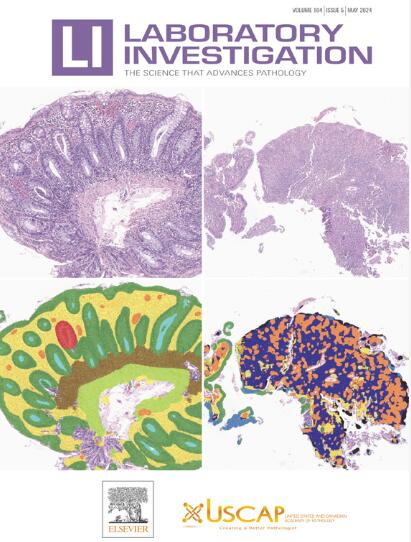浅表恶性周围神经鞘瘤的基因组图谱。
IF 5.1
2区 医学
Q1 MEDICINE, RESEARCH & EXPERIMENTAL
引用次数: 0
摘要
浅表恶性周围神经鞘瘤(SF-MPNST)是一种罕见的癌症,很难与纺锤形细胞黑色素瘤(SCM)或去瘤细胞黑色素瘤(DM)区分开来。人们对它们的生物学特性知之甚少。我们对SF-MPNST(8例)进行了全外显子组测序(WES)和RNA测序(RNA-seq),并将其与SCM(7例)、DM(8例)和深部MPNST(D-MPNST,8例)进行了比较。此外,还对 H3K27me3 和 PRAME 进行了免疫组化染色。SF-MPNST表现出介于D-MPNST和黑色素瘤之间的特征。患者比黑色素瘤患者年轻,比D-MPNST患者年长;预后分别较差和较好。SF-MPNST的肿瘤突变负荷(TMB)高于D-MPNST,低于黑色素瘤;仅在SF-MPNST和SCM之间(P = 0.0454)以及D-MPNST和SCM之间(P = 0.001,Dunn's Kruskal-Wallis事后检验)差异显著。尽管在一些常见的癌症相关基因中存在重叠的突变特征,COSMIC突变特征将DM和SCM与紫外线照射特征(SBS7a、7b)聚集在一起,将SF-和D-MPNST与DNA碱基切除修复缺陷(SBS30、36)聚集在一起。RNA-seq发现了SF-MPNST与SCM(1670个基因)、DM(831个基因)和D-MPNST(614个基因)之间的差异表达基因,其中一些有望发展成为免疫组化标记(SOX8、PLCH1)或辅助基因(MLPH、CALB2、SOX11、TBX4)。大多数D-MPNST(7/8,88%)的H3K27me3免疫反应呈弥漫性丧失,但在SF-MPNST(2/8,25%)中则表现出不同程度的斑片状丧失。大多数黑色素瘤(包括 11/15 例黑色素瘤)的 PRAME 均为阴性(20/31 例为 0+,占 65%),组间无显著差异(P=0.105,Kruskal-Wallis 检验)。相对于 MPNSTs,黑色素瘤中免疫细胞转录本的表达上调。下一代测序揭示了SF- MPNST、D-MPNST、SCM和DM之间的多种差异特征,包括肿瘤突变负荷、突变特征和差异表达基因。这些发现有助于促进我们对疾病发病机制的了解,并改进诊断方法。本文章由计算机程序翻译,如有差异,请以英文原文为准。
Genomic Landscape of Superficial Malignant Peripheral Nerve Sheath Tumor
Superficial malignant peripheral nerve sheath tumors (SF-MPNSTs) are rare cancers and can be difficult to distinguish from spindle cell (SCM) or desmoplastic (DM) melanomas. Their biology is poorly understood. We performed whole-exome sequencing and RNA sequencing (RNA-seq) on SF-MPNST (n = 8) and compared them with cases of SCM (n = 7), DM (n = 8), and deep MPNST (D-MPNST, n = 8). Immunohistochemical staining for H3K27me3 and PRAME was also performed. SF-MPNST demonstrated intermediate features between D-MPNST and melanoma. Patients were younger than those with melanoma and older than those with D-MPNST; the outcome was worse and better, respectively. SF-MPNST tumor mutational burden (TMB) was higher than D-MPNST and lower than melanoma; differences were significant only between SF-MPNST and SCM (P = .0454) and between D-MPNST and SCM (P = .001, Dunn’s Kruskal-Wallis post hoc test). Despite having an overlapping mutational profile in some common cancer-associated genes, the COSMIC mutational signatures clustered DM and SCM together with UV light exposure signatures (SBS7a, 7b), and SF- and D-MPNST together with defective DNA base excision repair (SBS30, 36). RNA-seq revealed differentially expressed genes between SF-MPNST and SCM (1670 genes), DM (831 genes), and D-MPNST (614 genes), some of which hold promise for development as immunohistochemical markers (SOX8 and PLCH1) or aids (MLPH, CALB2, SOX11, and TBX4). H3K27me3 immunoreactivity was diffusely lost in most D-MPNSTs (7/8, 88%) but showed variable and patchy loss in SF-MPNSTs (2/8, 25%). PRAME was entirely negative in the majority (0+ in 20/31, 65%), including 11/15 melanomas, and showed no significant difference between groups (P = .105, Kruskal–Wallis test). Expression of immune cell transcripts was upregulated in melanomas relative to MPNSTs. Next-generation sequencing revealed multiple differential features between SF- MPNST, D-MPNST, SCM, and DM, including tumor mutation burden, mutational signatures, and differentially expressed genes. These findings help advance our understanding of disease pathogenesis and improve diagnostic modalities.
求助全文
通过发布文献求助,成功后即可免费获取论文全文。
去求助
来源期刊

Laboratory Investigation
医学-病理学
CiteScore
8.30
自引率
0.00%
发文量
125
审稿时长
2 months
期刊介绍:
Laboratory Investigation is an international journal owned by the United States and Canadian Academy of Pathology. Laboratory Investigation offers prompt publication of high-quality original research in all biomedical disciplines relating to the understanding of human disease and the application of new methods to the diagnosis of disease. Both human and experimental studies are welcome.
 求助内容:
求助内容: 应助结果提醒方式:
应助结果提醒方式:


